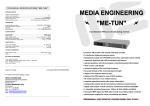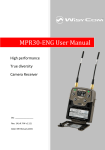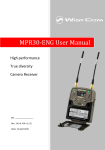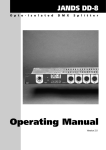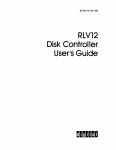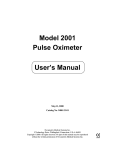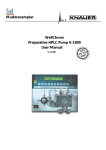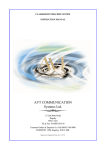Download Media Engineering ME-TUN User`s manual
Transcript
FM-SPY-T FM Sound Broadcasting Analyser USER‘S MANUAL FM-SPY-T Manual E; january 2005 e-mail: [email protected] web: www.mediaengineering.com www.me-tun.com www.fm-spy.com MEDIA ENGINEERING Markus Stocker ∗ Professional Broadcasting Systems ∗ Rainstr. 15 CH-8104 WEININGEN (ZH) ∗ Switzerland ∗ Phone: +41 1 750 66 88 ∗ Fax: +41 1 750 66 91 [email protected] ∗ www.mediaengineering.com ∗ www.fm-spy.com ∗ www.fm-spy.com FM-SPY-T USER`S MANUAL MEDIA ENGINEERING wants to thank you for selecting this MEDIA ENGINEERING product. For optimum performance and installation we recommend to read the following instructions carefully. In case of difficulties please contact one of our distributors or the manufacturing company. Manufacturers address: MEDIA ENGINEERING Markus Stocker Rainstrasse 15 CH - 8104 WEININGEN (ZH) Switzerland Phone Fax E-mail Web : : : : +41-1-750-66-88 +41-1-750-66-91 [email protected] www.mediaengineering.com The information in this documentation is subject to change. While every effort has been made to eliminate errors, MEDIA ENGINEERING disclaims liability for errors or for difficulties arising from interpretation of the information contained herein. MEDIA ENGINEERING makes no representations or warranties whatsoever with respect to the content of this document and specifically disclaims any implied warranties of merchantability or fitness for any particular purpose. MEDIA ENGINEERING reserves the right to make alterations as technical progress may warrant at the discretion of MEDIA ENGINEERING. MEDIA ENGINEERING has no obligation to notify any person or entity of any changes and/or revisions to this publication. MEDIA ENGINEERING reserves the right to change materials and specifications without notice. COPYRIGHT © MEDIA ENGINEERING All information contained in this documentation is the property of MEDIA ENGINEERING and is proprietary to MEDIA ENGINEERING and a trade secret of MEDIA ENGINEERING. No part of this publication may be copied, reproduced, transmitted, stored in a retrieval system, or translated into any language, in any form or by any means without the prior written consent of MEDIA ENGINEERING, Markus Stocker, CH-8104 Weiningen (ZH), Switzerland, [email protected] File: FM-SPY-T Manual E.DOC MEDIA ENGINEERING page 2/41 FM-SPY-T USER`S MANUAL MEDIA ENGINEERING Markus Stocker Rainstrasse 15 CH - 8104 WEININGEN (ZH) Switzerland Phone : Fax : E-mail : +41 1 750 66 88 +41 1 750 66 91 [email protected] EC Declaration of Conformity MEDIA ENGINEERING Markus Stocker, located in Rainstrasse 15, CH-8104 WEININGEN (ZH), Switzerland, hereby declare under our full responsibility that the product designated by "FM Sound Broadcasting Analyser FM-SPY-T" consisting of one 19”/1RU rack mountable device in its original metal housing conforms to the following standards: Standards used: EN 55022 : 1998 + A1 : 2000 EN 55024 : 1998 + A1 : 2001 FCC PART 15 Test center: EMC-TESTCENTER ZÜRICH AG Schaffhauserstrasse 580 CH-8052 ZÜRICH www.emc-testcenter.com Test report: EMC 094 / 02 dated 30/12/2002 All conformity tests have been made when the product is installed according to professional practice in a Recording or Broadcasting studio or similar environment. This product must not be used outside the specified environment. Weiningen: january, 10th, 2002 File: FM-SPY-T Manual E.DOC _____________________________ Markus Stocker President & CEO MEDIA ENGINEERING MEDIA ENGINEERING page 3/41 FM-SPY-T USER`S MANUAL CONTENT A. INSTALLATION INSTRUCTIONS .....................................................................................6 A.1. SAFETY CONDITIONS ..................................................................................................6 A.1.1. ELECTROMAGNETICAL INTERFERENCE ......................................................................7 A.1.2. ENVIRONMENT TEMPERATURE......................................................................................7 A.1.3. CAUTION WITH THE MAINS CABLE ...............................................................................7 A.1.4. DO NOT REMOVE COVER..................................................................................................7 A.2. INSTALLATION PROCEDURE ......................................................................................8 A.3. SETTING THE SAMPLING RATE FOR THE DIGITAL AUDIO OUTPUT .....................9 A.4. CABLING......................................................................................................................12 B. OPERATING INSTRUCTIONS ........................................................................................13 B.1. BASIC OPERATIONS ..................................................................................................13 B.1.1. STARTUP SEQUENCE........................................................................................................13 B.1.2. LIT UP KEYS .......................................................................................................................13 B.1.3. THE INITIAL STATE ..........................................................................................................14 B.1.4. TUNING IN TO A SPECIFIC FREQUENCY......................................................................15 B.1.5. SAVING A PRESET.............................................................................................................16 B.1.6. LOADING A PRESET..........................................................................................................17 B.1.7. SETTING THE INFO MODE...............................................................................................18 B.1.8. HEADPHONES VOLUME CONTROL...............................................................................19 B.2. EXTENDED OPERATIONS ..........................................................................................20 B.2.1. MENU FUNCTIONS ............................................................................................................20 B.2.2. STEPPING THROUGH PRESETS ......................................................................................21 B.2.3. FINE TUNING ......................................................................................................................22 B.2.4. SELECTING LOCAL rsp. REMOTE OPERATION ..........................................................23 B.2.5. SCANNING THE FM CHANNELS.....................................................................................25 B.2.6. SELECTING THE ANTENNA INPUT................................................................................27 C. THE FM-SPY COMPUTER APPLICATION.....................................................................28 C.1. THE PC INTERFACE ...................................................................................................28 C.2. SOFTWARE INSTALLATION ......................................................................................29 File: FM-SPY-T Manual E.DOC MEDIA ENGINEERING page 4/41 FM-SPY-T USER`S MANUAL C.3. STARTING THE FM-SPY APPLICATION....................................................................30 C.4. THE FM-SPY COMPUTER PROGRAM .......................................................................31 C.4.1. INTRODUCTION & OPERATIONAL CONCEPT .............................................................31 C.4.1. DESCRIPTION OF THE MAIN MENU POINTS ...............................................................32 C.4.1. DESCRIPTION OF THE DIFFERENT MEASUREMENTS ..............................................33 C.5. HOW TO MAKE MEASUREMENTS ............................................................................37 D. PINOUT OF 25 PIN D-TYPE CONNECTOR ON THE REAR SIDE ................................38 E. EXAMPLE OF HOW TO USE THE AUXILIARY INTERFACE........................................39 F. SUMMARY OF KEYBOARD COMMANDS .....................................................................40 G. TECHNICAL SPECIFICATIONS .....................................................................................41 * File: FM-SPY-T Manual E.DOC * * MEDIA ENGINEERING page 5/41 FM-SPY-T USER`S MANUAL A. INSTALLATION INSTRUCTIONS A.1. SAFETY CONDITIONS After removing any housing parts and electronic assemblies it’s possible to get access to live parts. It‘s essential to ensure that the subsequent safety rules are strictly observed: Servicing of electronic equipment must be performed by qualified personnel only. Before removing covers the equipment has to be switched off and the mains cable unplugged. When the equipment is open power supply capacitors have to be discharged with the help of a suitable resistor. When the equipment is open components, that carry havy electrical loads, such as power transistors and resistors as well as solenoid coils should not be touched before a cooling off interval, as a precaution to avoid burns. During servicing unprotected and operating equipment never touch bare wires or circuitry. During servicing unprotected and operating equipment use insulated tools only. During servicing unprotected and operating equipment never touch metal semiconductor cases because they may carry high voltages. For removing and installing electronic components, please follow the recommandations concerning the handling of MOS components. File: FM-SPY-T Manual E.DOC MEDIA ENGINEERING page 6/41 FM-SPY-T USER`S MANUAL A.1.1. ELECTROMAGNETICAL INTERFERENCE In case the FM-SPY-T is installed and operated in a strongly electromagnetical disturbed environment, signals of interferences can occur during reception of the FM Band. A.1.2. ENVIRONMENT TEMPERATURE Preferably install the equipment in a dry location with approximately 20 centigrades (room temperature) of ambient temperature. The ambient temperature has a large influence on the contrast of the LCD display. A.1.3. CAUTION WITH THE MAINS CABLE Always seize the mains cable at the plug. Do not pull on the cable and never touch the mains cable with wet hands, since this can cause a short-circuit or an electrical shock. Do not place equipment or a furniture on the mains cable. A damaged mains cable can cause fire or an electrical shock. Therefore examine the mains cable occasionally. Should it be damaged, get in contact with your next customer service in order to replace the cable. A.1.4. DO NOT REMOVE COVER To prevent electric shock, do not remove the cover. There are no user serviceable parts inside the FM-SPY-T. Refer servicing to qualified service personnel only. File: FM-SPY-T Manual E.DOC MEDIA ENGINEERING page 7/41 FM-SPY-T USER`S MANUAL A.2. INSTALLATION PROCEDURE Place the FM-SPY-T FM sound broadcasting analyser in a horizontal position, and do not place anything heavy on it. Never bring a magnet or magnetized objects near the device, because such will adversely affect the performance of the FM-SPY-T. Should it be necessary to change the sampling rate of the digital audio output to another value than the factory set 48kHz please refer to chapter A3. In case the FM-SPY-T has to be installed in a 19” rack the appropriate 19” brackets have to be mounted first in order to convert the table top device into a rack mountable device: a) loosen the two black M4 screws on the left and right side of the FM-SPY-T with the help of an appropriate 2.5mm PHILIPS screw driver b) put the two screws beside for they will be used again at the end c) unpack the two blue 19” brackets that are delivered as an add-on to every FM-SPY-T d) with a little movement from back to forward the brackets can be hooked into place while the U-shaped end of the bracket is grabbing around the end of the side wall. e) carefully replace the M4 screws from the left hand side rsp. from the right hand side and tighten them slightly (“two finger” torque) It’s a good rule of practice to mount at least a 19”/1RU blank panel on top and below each 19” rack mountable device. The same is true for the FM-SPY-T and - whenever possible - a blank panel above and below each FM-SPY-T should be mounted. FM-SPY-T with demounted 19” brackets (front view) File: FM-SPY-T Manual E.DOC MEDIA ENGINEERING page 8/41 FM-SPY-T USER`S MANUAL A.3. SETTING THE SAMPLING RATE FOR THE DIGITAL AUDIO OUTPUT The AES/EBU digital audio output on the rear side of the FM-SPY-T is featuring a sampling rate of 48kHz. This sampling rate is factory set and marked on the rear panel as such. In case this is not the propre sampling rate for a given application it’s possible to choose one of three other values: • 32kHz • 44.1kHz • 48kHz • 96kHz In order to change the sampling rate one needs to change the setting of two jumpers which are located inside the FM-SPY-T. Please refer to the procedure as described herewith: 1. Carefully study the SAFETY CONDITIONS in chapter A.1. on page 6 2. disconnect all cables from the FM-SPY-T. Make shure there is no power line connected anymore and the power switch is off. 3. loosen the three black M3 screws on the top front of the FM-SPY-T with the help of an appropriate 2.0mm PHILIPS screw driver in order to remove the cover. 4. put the three screws beside for they will be used again at the end 5. shift the cover 10mm to the rear and lift it off 6. locate the output amplifier board (called TADOBOARD, 72mm x 132mm) at the very back totally to the right. 7. loosen the three black M3 screws holding down the output amplifier board with the help of an appropriate 2.0mm PHILIPS screw driver 8. put the three screws beside for they will be used again at the end 9. with gentle force and a slight left to right rocking unplug and remove the board in a straight vertical direction File: FM-SPY-T Manual E.DOC MEDIA ENGINEERING page 9/41 FM-SPY-T USER`S MANUAL 10. locate the two jumpers J1 and J0 according to the PCB layout drawing: jumper J1 jumper J0 11. choose the new sampling rate and select the propre jumper setting: J1 fs 96 kHz 48kHz 44.1 kHz 32kHz J0 J1 J0 0 0 0 1 1 0 1 1 The table indicates the jumper settings as follows: - “0” indicates that no jumper has to be set - “1” indicates that a jumper has to be set example: in order to set a sampling rate of 48kHz (which is the factory setting) do not set a jumper at the left position J1 but set a jumper on the right position J0 File: FM-SPY-T Manual E.DOC MEDIA ENGINEERING page 10/41 FM-SPY-T USER`S MANUAL 12. put the output amplifier board back into the FM-SPY-T. Make shure the 22pin connector fits right into the socket underneath the cutout in the metallic shielding. The board is placed perfectly if there shows up an air gap between the board and the side wall of the FM-SPY-T of approximately 0.5mm 13. put in place the three black M3 screws in order to hold down the output amplifier board. Make shure the propre screws with the half spherical head are used 14. tighten the crews slightly (“two finger” torque) with the help of an appropriate 2.0mm PHILIPS screw driver. DO NOT USE STRENGTH. 15. replace the cover of the FM-SPY-T in a vertical motion so that there remains an air gap of approximately 10mm in the front section 16. shift the cover 10mm into the front direction in order to allow the bended shielding at the back grabing the U shaped rear side. 17. put in place the three black M3 screws in order to hold down the cover. Make shure the propre screws are used so that they can be lowered into the cover in order to achieve a totally flat surface. 18. reinstall the FM-SPY-T. 19. check your application with the new setting of the sampling rate. If it doesn’t work properly one of the following problems might have occurred: - the output amplifier boards 22pin connector is not properly connected to the socket and there is not a 0.5mm air gap on the right side of the board. Solution: go back to point 11. - the jumper setting is wrong. Solution: go back to point 10 and make shure that a “0” indicates no jumper but a “1” indicates a jumper. J1 is the left and J0 is the right jumper. - the jumper setting is not matching the features of your external device (e.g. a mixing console). Solution: check if your external device is able to handle one of the four selectable sampling rates and then choose one of these. File: FM-SPY-T Manual E.DOC MEDIA ENGINEERING page 11/41 FM-SPY-T USER`S MANUAL A.4. CABLING Connect an antenna cable to the “RF Input A” or “RF Input B” socket of the FM-SPY-T. These inputs are featuring F-type connectors (female chassis receptacles) with 75Ω impedance. switch OFF-POWER-ON RF Input A RF Input B AC mains input FM-SPY-T (back view) A matching coaxial antenna cable is needed. Contact your FM-SPY-T dealer for advice on a suitable cable to use. In case of using 75Ω antenna cables with IEC type of connectors two adapters F-IEC are supplied with every FM-SPY-T. Both antennae inputs are DC-free decoupled with RF transformers. This means the antennae inputs are completely earth-free; they are not having a connection to the chassis or to earth via the power cord. This decoupling prevents that the potential of the antenna cable (which is very seldom earth) is short-circuited with the earth supplied by the power supply, for this were leading to compensation currents which in turn is the most often reason for hum problems on the analog audio outputs. The FM-SPY-T has two transformerless servo balanced analog audio outputs (left & right channel) and a transformer coupled digital audio output (AES/EBU digital audio) on its rear side via standard XLR connectors. A headphones output connector (standard 1/4” Jack) on the front side is also provided. Only attach appropriate audio monitoring devices to these outputs of the FM-SPY-T. Connect the AC Mains Lead to the “AC mains input” socket of the FM-SPY-T. Caution: wrong handling may cause electric shocks (see A.1.3.: CAUTION WITH THE MAINS CABLE on page 7/22). File: FM-SPY-T Manual E.DOC MEDIA ENGINEERING page 12/41 FM-SPY-T USER`S MANUAL B. OPERATING INSTRUCTIONS B.1. BASIC OPERATIONS B.1.1. STARTUP SEQUENCE After proper installation of the FM-SPY-T (refer to A.2. INSTALLATION PROCEDURE on page 8), flip the “OFF-POWER-ON” switch on the rear side to the “ON” rsp. upper position in order to start up the device. Upon power on, FM-SPY-T enters the initialization sequence and displays the firmware version information on its LCD display (screen 1). FM-SPY-T R1.2 Media Engineering screen 1 Simultaneously all keys on the keypad will light up briefly1. A few seconds later, FM-SPY-T will enter the INITIAL state (refer to section B.1.3: INITIAL STATE on page 14) B.1.2. LIT UP KEYS FM-SPY-T has quite a large number of keys, but is nevertheless operated very simply. Only the lit up keys react on user input. No matter in what position of the input sequence the operator is, the FM-SPY-T will light up only those keys, which are meaningful for the next keystroke. 1 2 4 5 ↑PGM ↑25kc 3 LOAD DISP 6 0 LO/RE SCAN 7 8 9 SAVE ↓PGM ↓25kc ANTA/B MENU keypad 1: INITIAL STATE “keypad 1” shows an example: The keyboard is ready for user input on keys 1,8,9,LOAD or SAVE. All other keys are disabled and have no function. Thus, FM-SPY-T will guide you through the required steps to set up the tuner as desired. 1 This serves as a test for the LED illuminated push-buttons. File: FM-SPY-T Manual E.DOC MEDIA ENGINEERING page 13/41 FM-SPY-T USER`S MANUAL B.1.3. THE INITIAL STATE FM-SPY-T is memoryzing its settings during power-off and will - upon power up - display and tune to the frequency that was received just before power was lost or switched off. This frequency will be displayed in the top left position of the display after the startup sequence as shown in “screen 2”. 102.025 MHz mono ҰA RFL |■■■■| screen 2 Approximately in the middle of the top row of the LCD display the FM channel mode can be read out which is either "mono" or "stereo". On the top right of the display there is featured an antenna symbol plus the letters ‘A’ or ‘B’ in order to indicate the actual antenna input in use. The lower half of the LCD display is showing one out of three possible information lines (described in B.1.7.: SETTING THE INFO MODE on page 18). When the FM-SPY-T is in its INITIAL state the keypad will be lit up as already presented in “keypad 1” on page 13. Important note: FM-SPY-T resets and starts an internal timer each time a push-button is activated. If an input sequence is not finished within a few seconds, FM-SPY-T will automatically “fall back” to its INITIAL state. This feature is particularly convenient if there’s happening a mistake during inputting a command, for a “clear” or "reset" button is not necessary. One simply waits approximately 3 seconds and the keyboard “falls back” to the INITIAL state File: FM-SPY-T Manual E.DOC MEDIA ENGINEERING page 14/41 FM-SPY-T USER`S MANUAL B.1.4. TUNING IN TO A SPECIFIC FREQUENCY When the FM-SPY-T is powered up and waits in the INITIAL state (refer to section B.1.3: INITIAL STATE on page 14), the desired frequency, e.g. 103.250 MHz, may be inputted directly. There is no need to step through menu functions in order to get to a tuning menu. Under the condition, that the antenna input in use is already set properly (otherwise refer to B.2.6.: SELECTING THE ANTENNA INPUT on page 27) one can tune to any frequency within the entire FM band starting from the INITIAL state in predefined steps of 25kHz. As the FM band extends from 87.500 MHz to 108.000 MHz, the buttons that can be activated in first place are 8/9 or 1 corresponding to the first digit of the desired frequency. In case of inputting 103.250MHz, this would be a 1 and the screen and keypad looks like this: 1 MHz mono ҰA RFL |■■■■| screen 3 1 2 4 5 ↑PGM ↑25kc 3 LOAD DISP 6 0 LOCK SCAN 7 8 9 SAVE ↓PGM ↓25kc ANTA/B MENU keypad 2: AFTER INPUTTING “1” The only lit up button on the keypad now is button 0. This invites the user to press that button as the next one, as there is no valid frequency starting with a 1 followed by a digit other than 0. After pressing 0 one might continue to input the remaining digits, namely 3-2-5. The previously mentioned “fall back” feature (refer to section B.1.3: INITIAL STATE on the bottom of page 14) of the keyboard forces the user to do inputs within a given time interval. After inputting the second last digit (5), it’s not needed to input the last digit (0) for FM-SPY-T will always set the last digit automatically. As a summary: the entire sequence for the frequency in question is: 1-0-3-2-5 to tune to 103.250MHz out of the INITIAL state. File: FM-SPY-T Manual E.DOC MEDIA ENGINEERING page 15/41 FM-SPY-T USER`S MANUAL B.1.5. SAVING A PRESET Out of the INITIAL state of FM-SPY-T (refer to section B.1.3: INITIAL STATE on page 14), press the SAVE/MENU button once (the arrow in keypad 3 points to the SAVE key), 1 2 4 5 ↑PGM ↑25kc 3 LOAD DISP 6 0 LO/RE SCAN 7 8 9 SAVE ↓PGM ↓25kc ANTA/B MENU SAVE key keypad 3: INITIAL STATE whereupon “screen 4” will appear on the LCD display and the FM-SPY-T will ask for a preset number, in order to know where to save the preset. Preset numbers between 00 and 39 are allowed in order to save • the actual receiving frequency • the actual used antenna input A or B 103.250MHz mono ҰA Save: screen 4 After inputting the two preset number digits, FM-SPY-T will automatically fall back to its INITIAL state (refer to section B.1.3: INITIAL STATE on page 14). File: FM-SPY-T Manual E.DOC MEDIA ENGINEERING page 16/41 FM-SPY-T USER`S MANUAL B.1.6. LOADING A PRESET Loading (restoring) a preset is similar to saving one. On the keypad the LOAD button (the arrow in keypad 4 points to the LOAD key) plus a 2-digit preset number to load (between 00 and 39) has to be keyed in. LOAD key 1 2 3 LOAD DISP 4 5 6 0 ↑PGM ↑25kc LO/RE SCAN 7 8 9 SAVE ↓PGM ↓25kc ANTA/B MENU keypad 4: INITIAL STATE 103.250MHz mono ҰA Load: screen 5 After inputting the two preset number digits, FM-SPY-T will fall back automatically to the INITIAL state (refer to section B.1.3: INITIAL STATE on page 14). File: FM-SPY-T Manual E.DOC MEDIA ENGINEERING page 17/41 FM-SPY-T USER`S MANUAL B.1.7. SETTING THE INFO MODE The bottom row of the LCD display is featuring one out of three possible info modes: 1. RFL (Radio Frequency Level) in a bargraph presentation indicating the strength of the antenna signal (at the RF antenna input in use). 102.025 MHz mono ҰA RFL |■■■■| 2. RFL (Radio Frequency Level) in a numerical representation in "dBµV" (the reference level is 1µV what equals 0dBµV, e.g. 46dBµV = 200µV) 102.025 MHz mono ҰA RFL 46dBµV 3. RDS data of the PSNS code (program service name segment) 102.025 MHz mono ҰA Radio 01 If the actually tuned in station is not broadcasting any RDS information the LCD displays bottom line remains blank (blue). Activating the LOAD button twice is stepping through all three info modes: 1 2 3 LOAD DISP 2x 4 5 6 0 ↑25kc LO/RE SCAN 7 8 9 SAVE ↓PGM ↓25kc ANTA/B MENU ↑PGM keypad 5 After each double-press of the LOAD button, the channel info mode changes its state. File: FM-SPY-T Manual E.DOC MEDIA ENGINEERING page 18/41 FM-SPY-T USER`S MANUAL B.1.8. HEADPHONES VOLUME CONTROL On the front side of the FM-SPY-T there is totally to the right side the headphones connector. This is a standard ¼” Jack as very widely used for headphones worldwide. headphones volume UP volume DOWN There are two push-buttons to the left of the headphones connector. These are serving for the headphones volume control in a highly sophisticated microprocessor controlled manner: • after powering up the FM-SPY-T both push-buttons are illuminated. This is signalling that the volume control is in its “normal” (default) position. This position is equal to approximately 12dB below maximum volume. • shortly pressing onto one of the buttons is increasing rsp. decreasing the headphones volume by 1dB. When the volume ends up to be BELOW the default value the lower button (DOWN) is illuminated and when it’s ABOVE the default value the upper button is illuminated. • pressing one of the buttons for more than approximately 1 second leads to a volumejump of 1dB and - after this - to a fine fading up rsp. down (until eventually the maximum at 0dB or the minimum at -42dB is achieved) • pressing briefly onto both buttons simultaneaously is forcing the volume to jump to its lowest possible value (approximately 42dB below maximum volume) • pressing onto both buttons simultaneously for more than approximately 1 second lets the volume first jump to its minimum value (-42dB) and then up to its “normal” default value (12dB below maximum) File: FM-SPY-T Manual E.DOC MEDIA ENGINEERING page 19/41 FM-SPY-T USER`S MANUAL B.2. EXTENDED OPERATIONS B.2.1. MENU FUNCTIONS Some special features are accessible through MENU functions. The MENU is activated by a double-press on the SAVE/MENU button out of the INITIAL state (refer to section B.1.3: INITIAL STATE on page 14). 1 2 3 LOAD DISP 4 5 6 0 ↑PGM ↑25kc LO/RE SCAN 7 8 9 SAVE ↓PGM ↓25kc ANTA/B MENU 2x keypad 6: INITIAL STATE A double-press of the SAVE/MENU button is switching to the MENU functions and the LCD display of the FM-SPY-T will look like “screen 6”. 102.025 MHz mono ҰA RFL |■■■■| P03 screen 6 The actual loaded preset number (which must not necessarily contain the same frequency as is shown in the top row) is displayed in the bottom row at the right hand side. The illumination pattern of the keypad is now looking like “keypad 7”: 1 2 3 LOAD DISP 4 5 6 0 ↑25kc LO/RE SCAN 7 8 9 SAVE ↓PGM ↓25kc ANTA/B MENU ↑PGM keypad 7: MENU File: FM-SPY-T Manual E.DOC MEDIA ENGINEERING page 20/41 FM-SPY-T USER`S MANUAL During using MENU functions the automatic “fall back to INITIAL state” feature of the FMSPY-T is still active. After a certain time without any user input, FM-SPY-T will quit the MENU state and fall back to the INITIAL state (refer to section B.1.3: INITIAL STATE on page 14). When pressing the SAVE key from the MENU state, FM-SPY-T will be switched back to INITIAL state, too. B.2.2. STEPPING THROUGH PRESETS One can load a preset (as described in section B.1.6. LOADING A PRESET on page 17) by pressing the LOAD button and entering the desired 2-digit preset number. In case it's unknown where to find a given preset in the memory, it’s possible to step through all presets by pressing the ↑PGM and ↓PGM keys for in-crementing rsp. de-crementing the preset number out of the MENU state (refer to section B.2.1. MENU FUNCTIONS on page 20). 1 ↑PGM 2 3 LOAD DISP 4 5 6 0 ↑25kc LO/RE SCAN 7 8 9 SAVE ↓PGM ↓25kc ANTA/B MENU ↑PGM ↓PGM keypad 9: MENU During stepping the actual preset number can always be monitored on the LCD display. The FM-SPY-T has a preset memory with preset numbers ranging from 00 to 39. It’s possible to step up and down only within this range of memory addresses. While in MENU state and the button ↑PGM or ↓PGM is activated FM-SPY-T is not falling back anymore. The activation of any one of these buttons is stopping the fall back mechanism and lets the user step conveniently through all presets (stepping up or stepping down). Even a fine tuning in 25kHz steps with buttons ↑25kc or ↓25kc is possible without falling back to the INITIAL state. An activation of any other lit-on button triggers the desired function and starts the fall back routine again. File: FM-SPY-T Manual E.DOC MEDIA ENGINEERING page 21/41 FM-SPY-T USER`S MANUAL B.2.3. FINE TUNING By entering the MENU state and using the push-buttons ↑25kc or ↓25kc on the keypad, one can alter the FM receivers tuning frequency in 25kHz steps up or down. 25kHz step up 1 2 3 LOAD DISP 4 5 6 0 ↑25kc LO/RE SCAN 7 8 9 SAVE ↓PGM ↓25kc ANTA/B MENU ↑PGM keypad 10: MENU 25kHz step down When pressing one of these buttons continuously, the stepping will be faster. The frequency range of the receiver (87.5MHz to 108.0MHz) can not be exceeded and the stepping will be stopped before going out of band. File: FM-SPY-T Manual E.DOC MEDIA ENGINEERING page 22/41 FM-SPY-T USER`S MANUAL B.2.4. SELECTING LOCAL rsp. REMOTE OPERATION In case the FM-SPY-T is hooked up to a PC via the USB interface some tuner settings (e.g. tuning to a specific RF receiving frequency) can be established from “remote” using the FMSPY PC application program. This might result in a conflict with settings made “locally” on the keypad. In order to prevent such conflicts MEDIA ENGINEERING has decided that the operator able to operate the hardware device FM-SPY-T is the so called master. He has to make the decision if the command mode “local” or “remote” has to be chosen and selected via the MENU state (refer to section B.2.1. MENU FUNCTIONS on page 20) and the LO/RE button (see “keypad 11”). 1 2 3 LOAD DISP 4 5 6 0 ↑25kc LO/RE SCAN 7 8 9 SAVE ↓PGM ↓25kc ANTA/B MENU ↑PGM keypad 11 The entire sequence to put the FM-SPY-T into the “remote” mode is: MENU-MENU-LO/RE. As soon as the LO/RE button is activated, the following screen will appear: REMote is active! screen 7 File: FM-SPY-T Manual E.DOC MEDIA ENGINEERING page 23/41 FM-SPY-T USER`S MANUAL The keypad lightmap for an active “remote” operation mode is as follows: 1 2 3 LOAD DISP 4 5 6 0 ↑25kc LO/RE SCAN 7 8 9 SAVE ↓PGM ↓25kc ANTA/B MENU ↑PGM keypad 12: REMote operation mode active! Pressing the same push-button sequence MENU-MENU-LO/RE within a propre time-interval (to prevent fall back after approximately 3 seconds) will bring the FM-SPY-T back to the “local” operation mode. File: FM-SPY-T Manual E.DOC MEDIA ENGINEERING page 24/41 FM-SPY-T USER`S MANUAL B.2.5. SCANNING THE FM CHANNELS The automatic FM channel scanning function of the FM-SPY-T is a useful feature when the device has been installed in a new location with entirely different radio sound broadcasting stations as at the previous location. When enabling the automatic scanning function, FMSPY-T scans the FM frequency band from 108.000MHz downwards to 87.500MHz and stores all channels with strong enough RF levels (the threshold is set to 50dBµV) to its internal memory. The channels are stored in a reverse order to the internal memory: The first channel FMSPY-T finds will be saved to program number 39, the second one to program number 38 and so on. As the user of FM-SPY-T will normally have his favourite channels stored in the first few preset positions (e.g. preset 00 to preset 08), the scanning function will not overwrite the user channel setup when storing all channels which were found during scanning to the last positions in memory. In order to start a scan, the MENU state of the FM-SPY-T has to be achieved by doublepressing LOAD/MENU and then the SCAN button (see keypad 13) has to be pressed: 1 2 3 LOAD DISP 4 5 6 0 ↑PGM ↑25kc LO/RE SCAN 7 8 9 SAVE ↓PGM ↓25kc ANTA/B MENU keypad 13: MENU Because scanning might overwrite some previously stored presets in the internal memory, FM-SPY-T will prompt you before continueing (see screen 12). scan? LOAD=yes SAVE=no screen 8 File: FM-SPY-T Manual E.DOC MEDIA ENGINEERING page 25/41 FM-SPY-T USER`S MANUAL By pressing the LOAD button FM-SPY-T will effectively start the scanning function. During scanning, there will show up a backlight sequence of the LED illuminated push-buttons (simulating a tuning wheel rotating counter clock wise) and the tuning frequency will be decreased in 100kHz steps starting from 108.000MHz. Also shown is the actual preset number that FM-SPY-T will use to store a channel. 107.900MHz stereo ҰA RFL |■■■■| P39 screen 9 When FM-SPY-T finds a strong enough channel (the threshold is set to 50dBµV) the center key “5” on the keypad will light up briefly and the preset number on the LCD display will be decremented by 1. After reaching the bottom end of the FM band (87.500MHz), FM-SPY-T will show the number of stations that have been found and saved during the scan. 05 programs found! screen 10 By hitting the LOAD button FM-SPY-T will load the last station it has found (in case of “05 programs found” this is preset number 35) and returns to its INITIAL state (refer to section B.1.3: INITIAL STATE on page 14). In order to check which programs FM-SPY-T has found during scanning, the “stepping through presets” function (as described in chapter B.2.2. STEPPING THROUGH PRESETS on page 21) can be used. File: FM-SPY-T Manual E.DOC MEDIA ENGINEERING page 26/41 FM-SPY-T USER`S MANUAL B.2.6. SELECTING THE ANTENNA INPUT To change the antenna input in use, enter the MENU state (refer to B.2.1.: MENU FUNCTIONS on page 20) and press button ANTA/B on the keypad. 1 2 3 LOAD DISP 4 5 6 0 ↑25kc LO/RE SCAN 7 8 9 SAVE ↓PGM ↓25kc ANTA/B MENU ↑PGM keypad 8: MENU ANT A/B After pressing this key, FM-SPY-T will toggle the antenna input from A→B or from B→A, depending on the previous selection of the antenna input. Note: FM-SPY-T is featuring two antenna inputs for there are situations in which it’s necessary to monitor not only radio stations that can be received with the help of an aerial (e.g. an antenna on the roof) but also the ones coming in via CATV (CAble TV network). The feature is also helpful when a directional antenna is used in order to receive a certain station with a nondistorted or strong enough RF signal. In this case an omnidirectional antenna (probably a ground plane connected to the second antenna input) might be used to receive the other stations of the FM band. * File: FM-SPY-T Manual E.DOC * * MEDIA ENGINEERING page 27/41 FM-SPY-T USER`S MANUAL C. THE FM-SPY COMPUTER APPLICATION C.1. THE PC INTERFACE The FM-SPY-T is a normal USB 1.1 device. The data transfer rate on the interface of the FM-SPY-T reaches up at 7Mbps. The USB cable to use has to feature a rectangular type-A connector on one side and a quadratic type B connector on the other side. The maximum cable length is specified to: Lmax = 5.0 meters Please connect the quadratic type B connector into the USB socket on the rear side of the FM-SPY-T: USB connector The rectangular type-A USB connector is put into the computers USB 1.1 interface AFTER THE SOFTWARE INSTALLATION (refer to section C.2. on the next page) IMPORTANT NOTE: FIRST install the software SECOND make the USB connection Remark: According to the norms it should be possible to use transfer rates on a USB 1.1 interface of up to 12Mbps maximum theoretical value. Nevertheless some interfaces (hardware semiconductor chip sets) do not provide this high transfer rate. There are computers that are not able to handle 7Mbps on the USB 1.1 port because of hardware limitations. This means that situations can arise in which the FM-SPY computer program can not run properly because of hardware problems. In order to verify this try to install the FM-SPY application on an other machine. File: FM-SPY-T Manual E.DOC MEDIA ENGINEERING page 28/41 FM-SPY-T USER`S MANUAL C.2. SOFTWARE INSTALLATION The software installation under MICROSOFT WINDOWS is quite easy to achieve. The software runs on all MICROSOFT WINDOWS operating systems incorporating the handling of USB 1.1 interfaces such as WIN98, WIN2000, WINXP but not on WINNT. IMPORTANT NOTE: FIRST install the software SECOND make the USB connection The installation process is started by running the installation program “setup.exe” directly from the CD-ROM with the original FM-SPY software package or from a previously created directory on the harddrive containing a copy of the CD-ROM. During the installation process all necessary drivers plus the FM-SPY application will be installed on the PC. SECOND (and only now): ! establish the USB connection from the FM-SPY to the PC while the PC is running. The operating system is then recognizing the new device and is searching and installing the proper drivers automatically. In case the the FM-SPY-T is connected to the PC before the software is installed it might be necessary to install the drivers manually. Test procedure: After the software installation but while the FM-SPY application is NOT running switch off the FM-SPY-T hardware device with its power switch on the rear side. After some seconds switch it back on again and watch how a) b) the frontpanel LED named USB is illuminated the two alarm LEDs AL1 and AL2 will go dark after approximately 2 seconds If both testpoints a) and b) are successfully outperformed the PC has detected the FM-SPYT as a new USB device, loaded the propre driver(s) and downloaded the propre firmware into the USB processor located in the FM-SPY-T hardware device. The computer is ready to start the FM-SPY application. File: FM-SPY-T Manual E.DOC MEDIA ENGINEERING page 29/41 FM-SPY-T USER`S MANUAL C.3. STARTING THE FM-SPY APPLICATION Before running the software application it’s necessary to switch the FM-SPY-T into the so called "remote operation mode". This is done by pressing the sequence SAVE -> SAVE -> LO/RE on the frontpanel keyboard (please refer to section B.2.4. on page 23) . If this sequence is not inputted the FM-SPY-T is still awaiting commands from the keyboard and is not able to be remotely controlled from the PC via the USB connection. Now start the FM-SPY computer application program by running the file “fmspysdi.exe” or click onto a previously defined shortcut rsp. a predefined icon on the desktop. The Main Window opens up and displays the Protocol section which can be used to fill in special infos regarding the coming measuring task (please refer to detailed handling description on next page). During this process the computer is not talking to the FM-SPY-T and is also not receiving any data from it. In order to start the data transfer process with the FM-SPY-T via the USB interface the following icon in the toolbar has to be clicked: As long as the data transfer process is not started the FM-SPY-T is not doing anything and cannot talk to the computer and cannot receive any commands from it. The very first time the data transfer process is started the FM-SPY program is asking for the inputting of a so called SOFTWARE KEY CODE This code is related to the serial number of the hardware device and comes together with the original CD-ROM. In case the software key code is lost please ask your FM-SPY-T dealer or MEDIA ENGINEERING for advice. After inputting the key code the computer memorizes it in the so called WINDOWS®-registry. From that moment on it’s not necessary to key in the code again, At least as the same FM-SPY-T box is hooked up to the same computer. - if an error message window appears telling “check cable and power” please do so. if an error message window appears telling “device in local state” plese switch the FMSPY-T into the remote operating mode by keying in SAVE - SAVE - LO/RE if any other error messages appear there might be a conflict with the USB drivers. In such situations de-install the FM-SPY application properly and install from new. File: FM-SPY-T Manual E.DOC MEDIA ENGINEERING page 30/41 FM-SPY-T USER`S MANUAL C.4. THE FM-SPY COMPUTER PROGRAM C.4.1. INTRODUCTION & OPERATIONAL CONCEPT The software was designed with the goal in mind to maximize an ergonomic measuring sequence. The steps while working through the measuring process is similar to the writing of a measuring protocol. But the different tasks can be chosen manually as well. With this flexibility it's possible to outperform “quick'n dirty” measurements as well as detailed measuring campaigns in great length and during a longer time period with protocols. protocol header menu measuring area The main window is split in three parts: • • • protocol header menu measuring area The content of the measuring area is depending on the chosen menu function. File: FM-SPY-T Manual E.DOC MEDIA ENGINEERING page 31/41 FM-SPY-T USER`S MANUAL C.4.1. DESCRIPTION OF THE MAIN MENU POINTS name description Protocol This area allows the inputting of administrative data. It consists of three parts. In the part “Operator” it's possible to key in the name of the operator and/or the name of the organisation. In the part “Antennae” it's possible to key in detailed informations and settings regarding the antennae in use. In the part “Results” it’s possible to specify the directory for the storing of the measured data. It's optional to input some comments as well. Parameter In this section it's possible to define the main hardware settings like e.g. the receiving frequency of the tuner and the antenna input in use for the coming up measurement. In the same section one can outperform a so called panorama scan over a specified or the entire FM band in one of three step sizes. A panorama scan is useful in case the radio stations frequencies are unknown or an overview over the FM band is useful. Measurement This area is containing the actual measuring tasks. Please refer to the appropriate detailed descriptions in chapter C.4.1. beginning on page 33. File: FM-SPY-T Manual E.DOC MEDIA ENGINEERING page 32/41 FM-SPY-T USER`S MANUAL name description Alarm Settings In the alarm section it's possible to define and manage details regarding alarms. The definition of threshold values is possible for different measuring results. In case a certain threshold is reached the propre alarm is triggered and a remark in the logging file is made. In case a definition of an activated alarm is fullfilled the alarm is triggered. As a result one of the actions “SET Alarm 1” or SET Alarm 2” can be outperformed. In such situations the alarm LED on the frontpanel labeled AL1 rsp. AL2 is illuminated and - parallel to this - a photocoupler switch is activated which in turn allows earthfree signalisations to external devices connected to the AUXILIARY 25pin D-type connector on the rear side (see page 38). One special application is the definition of a simple “Silence Sensor” rsp. “loss of audio” alarm: if the deviation is lower than a specified threshold value (e.g. 12…15kHz) for more than a certain time period (e.g. 60 seconds) one might suspect that the radio station is only broadcasting the stereo pilot tone (approx. 7kHz dev.) plus the RDS signal (approx. 3kHz) and has lost its audio (may be because of a computer problem in the harddisk audio system). C.4.1. DESCRIPTION OF THE DIFFERENT MEASUREMENTS The main task “MEASUREMENT” shows a number of so called TABs for it’s split in various measuring tasks such as Signal Scope, Signal Quality, MPX Deviation, MPX Power, MPX Spectrum and RDS Data. ! All measurements are outperformed according to the recommendations of the ITU-R ! File: FM-SPY-T Manual E.DOC MEDIA ENGINEERING page 33/41 FM-SPY-T USER`S MANUAL meas. task (tab) description Signal Scope displaying the demodulated multiplex signal and the RF antenna signal strength signal. Both are in the time domain and similar to the display of a cathode ray oscilloscope. Signal Quality This task is displaying all data in order to decide if a specific measuring situation is allowing results according to the ITU-R. It's checked if the amount of multipath receiving and the RF signal strength is according to ITU-R 1268. Also displayed is the RDS BER (Bit Error Rate). File: FM-SPY-T Manual E.DOC MEDIA ENGINEERING page 34/41 FM-SPY-T USER`S MANUAL name description MPX Deviation Displaying the momentary peak frequency deviation in a direct and statistical form. A micro peak filter is filtering single peaks. MPX Power Displaying the calculation of the power of the multiplex signal (according to ITU-R). Each point is the result of a 60 seconds integration. File: FM-SPY-T Manual E.DOC MEDIA ENGINEERING page 35/41 FM-SPY-T USER`S MANUAL MPX Spectrum Displaying the demodulated multiplex signal in the frequency domain. Red vertical lines are marking the position of the pilot tone at 19kHz, the DSSC stereo difference signal at 38kHz and the RDS modulation at 57kHz. Different windowing techniques can be chosen for the FFT. RDS Data Displaying the content of the RDS data stream. File: FM-SPY-T Manual E.DOC MEDIA ENGINEERING page 36/41 FM-SPY-T USER`S MANUAL C.5. HOW TO MAKE MEASUREMENTS 1. Connect a suitable antenna to the FM-SPY (rsp. FM-SPY-T) and power up the device. Make shure the FM-SPY (-T) is having an USB connection the the computer. 2. Put the FM-SPY-T in the "remote operation mode" by pressing SAVE -> SAVE -> LO/RE 3. Start the FM-SPY application. 4. Start the data transfer process by clicking onto this symbol in the tool bar: 5. In case no error message is appearing the hardware is ready for measurings. 6. In case an error message is appearing it's useful to check if the FM-SPY is listed in the hardware device manager (section USB-controller). Otherwise the USB connection to the FM-SPY has to be checked. 7. Change to the section PROTOCOL and input the necessary data. The inputs are read automatically as soon as the cursor leaves the field. 8. Change to the section PARAMETER and make the necessary adjustements and/or outperform a panorama scan. 9. Change to the section ALARMS and define the propre alarms. 10. The main measuring task can now be started: click onto the PLAY symbol (triangle) in the tool bar. 11. As long as the measuring is running (active) it's possible to switch from tab to tab in order to follow up and/or read out the development of the results. 12. All resuts are written into the logging file continuously. * File: FM-SPY-T Manual E.DOC * * MEDIA ENGINEERING page 37/41 FM-SPY-T USER`S MANUAL D. PINOUT OF 25 PIN D-TYPE CONNECTOR ON THE REAR SIDE The 25pin D-type connector AUXILIARY INTERFACE on the rear side of the FM-SPY-T is a female chassis type receptacle. While looking onto the connector from the rear the pinout of this connector is as follows: PIN # Signal / Description 1 2 3 4 5 6 7 8 9 10 11 12 13 14 15 16 Gnd (Chassis) MPX-OUT (+5.5....+6.5dBu @ nom dev.@600Ω) SCADATA RDSCLOCK (1187.5Hz) RDSDATA (according to CENELEC EN 50067) Opto1 Emitter (RDS loss alarm) Opto2 Emitter (STEREO loss alarm) Opto3 Emitter (CARRIER loss alarm) Opto4 Emitter (TA flag) Opto5 Emitter (TP flag) Opto6 Emitter (AL2 alarm (via FM-SPY program)) Opto5 Emitter (AL1 alarm (via FM-SPY program)) Gnd (Chassis) 0V/5V binary signal: local=LOW/remote=HIGH not connected SCAAUDIO RDSQUAL (PWM signal: T=842µs, good=HIGH, bad=LOW) +15VDC, PTC fused (Ihold=0.5A@230C) Opto1 Collector (RDS loss alarm) Opto2 Collector (STEREO loss alarm) Opto3 Collector (CARRIER loss alarm) Opto4 Collector (TA flag) Opto5 Collector (TP flag) Opto6 Collector (AL2 alarm (via FM-SPY program)) Opto6 Collector (AL1 alarm (via FM-SPY program)) 17 18 19 20 21 22 23 24 25 File: FM-SPY-T Manual E.DOC MEDIA ENGINEERING page 38/41 FM-SPY-T USER`S MANUAL E. EXAMPLE OF HOW TO USE THE AUXILIARY INTERFACE The schematic diagram represents the internal ciruitry of the FM-SPY-T in regard of the AUXILIARY INTERFACE. Also two application examples are shown: the implementation of relais coupled switching outputs with the use of an internal rsp. external DC source. File: FM-SPY-T Manual E.DOC MEDIA ENGINEERING page 39/41 FM-SPY-T USER`S MANUAL F. SUMMARY OF KEYBOARD COMMANDS 1st keystroke 2nd keystroke 3rd keystroke 4th keystroke 5th keystroke 3 2 5 ↑PGM …………… ↓PGM …………… ↑25kc …………… ↓25kc …………… 6th keystroke TUNING to 103.250 MHz: 1 0 SAVING PRESET NO. 27: SAVE 2 7 LOADING PRESET NO. 19: LOAD 1 9 SEQUENCING THE INFO MODE: DISP DISP STEPPING UP THROUGH PRESETS: MENU MENU ↑PGM STEPPING DOWN TROUGH PRESETS: MENU MENU ↓PGM FINE TUNING IN 25kHz STEPS UPWARDS: MENU MENU ↑25kc FINE TUNING IN 25kHz STEPS DOWNWARDS: MENU MENU ↓25kc SWITCHING TO “REMOTE” CONTROL MODE (tuner operation via PC program): MENU MENU LO/RE SWITCHING TO “LOCAL” CONTROL MODE (tuner operation via keypad): MENU MENU LO/RE MENU SCAN SCANNING : MENU LOAD …………… LOAD SELECTING (TOGGLING) THE ANTENNA INPUT : MENU MENU File: FM-SPY-T Manual E.DOC ANTA/B MEDIA ENGINEERING page 40/41 FM-SPY-T USER`S MANUAL G. TECHNICAL SPECIFICATIONS ANTENNAE INPUTS number of antennae inputs ............................................................................................... 2 antenna input impedance .…........................................................................................ 75 Ω antenna input connector type......................................................................... F (receptacle) antenna input circuit............................................................ transformer balanced earthfree antenna selecting switch: ………………..……………. the unused input is 75 Ω terminated FM RECEIVER receiving frequency range .....................................…………….. 87.500MHz - 108.000MHz receiving frequency step width ...…………...........................................................…... 25kHz sensitivity .................................................................................................. 5uV @ 30dBSINAD intermodulation ..…........................................................................ 5mV (73dB) suppression scanning threshold RF signal strength …….………………………………….……….. 50dBµV carrier loss threshold RF signal strength ……………………………………………..... 25dBµV number of presets ………………………………………………………………………..………40 COMPUTER INTERFACE Type ....................................................................................................................... USB1.1 Datarate ....................................................................................…... approximate 7Mbit/sec Maximum Cable Length ...........................................................…............................ 5 meter ALARM OUTPUTS connector type .................................................... D-Sub, 25 pin, female chassis receptacle alarm outputs ............................................................................................... 7 photocouplers specification photocouplers ..….......................... UCEmax = 40V / ICmax = 80mA / UCEsat = 0.3V DC supply output ...................................……………...…..…………….. +15.0 VDC, stabilized 0 resettable fused DC supply output …..........…......………………….. PTC, Ihold = 0.5A @ 23 C POWER SUPPLY mains power voltage ..........................................................................……….. 90 - 250 VAC mains power line frequency .................................................................................. 47 - 63 Hz power consumption .…………................................................................................ < 25 Watt PHYSICAL DIMENSIONS width x depth x height ......................................................................…... 380 x 260 x 44 mm weight .......................................................................................................................... 4.5 kg INCLUDED ACCESSORIES: 1 pcs. power cord, 3wire 2 pcs. antenna connection adapter type "F-male" ⇔ "IEC-male" 2 pcs. 19"/1RU rack mount kit 1 pcs. user's manual 1 pcs. CD-ROM with FM-SPY PC application program 1 pcs. software key code document subject to change File: FM-SPY-T Manual E.DOC © Copyright MEDIA ENGINEERING MEDIA ENGINEERING page 41/41










































